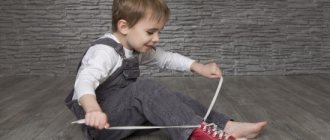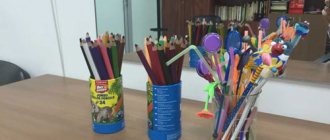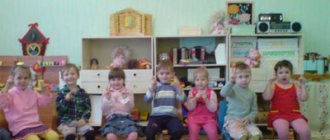In speech therapy, general underdevelopment of speech ( children with severe speech impairments ) is understood as a form of speech disorders in which the formation of all components of speech is impaired. The concept of “general speech underdevelopment” presupposes the presence of symptoms of immaturity (or developmental delay) of all components of the speech system (phonetic-phonemic aspect of speech, lexical composition, grammatical structure of speech).
General speech underdevelopment may have a different mechanism and, accordingly, a different structure of the defect. It can be observed with alalia, dysarthria, stuttering and other disorders.
The structure of a speech defect is understood as the totality (composition) of speech and non-speech symptoms of a given speech disorder and the nature of their connections.
When eliminating speech disorders, the following concepts are used: speech therapy, correction, compensation, development, “training,” “upbringing,” “correctional and developmental education,” etc.
Speech therapy is a pedagogical process aimed at correcting and compensating for speech disorders and at raising and developing a child with a speech disorder.
Children with severe speech impairments and some types of speech impairments:
Dysphonia (aphonia) is the absence or disorder of phonation due to pathological changes in the vocal apparatus. (voice impairment, phonation impairment, vocal impairment).
Bradylalia is a pathologically slow rate of speech.
Tahilalia is a pathologically accelerated rate of speech.
Logoneurosis is a violation of the tempo-rhythmic organization of speech, caused by a convulsive state of the speech apparatus.
Dyslalaya is a violation of sound pronunciation with normal hearing and intact innervation of the speech apparatus.
Dysarthria is a violation of the pronunciation aspect of speech caused by insufficient innervation of the speech apparatus.
Alalaya is a complete or partial loss of speech caused by local lesions of the brain.
| So, general speech underdevelopment ( children with severe speech impairments ) - various complex speech disorders in which the formation of all components of the speech system related to the sound and semantic aspects is impaired with normal hearing and intelligence. |
Depending on the degree of development of speech means in a child, general speech underdevelopment is divided into three levels:
General underdevelopment of level I;
General underdevelopment of level II;
General underdevelopment of level III.
Children with severe speech impairments - level I, II, III
Children with severe speech impairments of level I. Verbal means of communication are extremely limited. Children's active vocabulary consists of a small number of vaguely pronounced everyday words, onomatopoeias and sound complexes. Pointing gestures and facial expressions are widely used.
Children with severe speech impairments of level II. The child’s speech activity increases. Communication is carried out through a distorted and limited stock of commonly used words. At this level it is possible to use pronouns and simple prepositions. Children can answer questions related to family and familiar events in their surrounding life. Use simple sentences consisting of 3-4 words. Vocabulary significantly lags behind the age-specific norm. There are gross errors in the use of grammatical structures. (the book lies on the table - “kiga goes then”). The phonetic side of speech is characterized by the presence of numerous distortions of sounds, substitutions and mixtures. (“dupa” - hand, “pat nika” - five books, “strawberry” - kukika)
General speech underdevelopment of level III is characterized by the presence of extensive phrasal speech with elements of lexico-grammatical and phonetic-phonemic underdevelopment. Characteristic is the undifferentiated pronunciation of sounds (“Syapogi”, “syuba”, “syaynik”, “syaplya”). In children with severe speech impairments, agrammatisms are observed: errors in the agreement of numerals with nouns, adjectives with nouns in gender, number, and case. A large number of errors are observed in the use of both simple and complex prepositions.
The impact on a child with a speech disorder is associated with the normalization of social contacts with surrounding people.
Correction of speech disorders is carried out taking into account leading activities. In preschool children, it is carried out in the process of play activity, which becomes a means of developing analytical-synthetic activity, motor skills, sensory sphere, enriching the vocabulary, mastering language patterns, and shaping the child’s personality.
Still have questions?
Who is a speech therapist? educational and methodological material on speech therapy (senior group) on the topic
Speech therapy intervention is carried out in stages:
- preparatory,
- sound production,
- automation of sound and, in cases of replacing one sound with another or mixing them,
- stage of differentiation.
I. Preparatory stage. The purpose of this stage is to prepare for the correct perception and reproduction of sound. At this stage, work proceeds simultaneously in several directions:
– formation of precise movements of the organs of the articulatory apparatus; – formation of a directed air stream; – development of fine motor skills of the hands; – development of phonemic hearing; – practicing reference sounds.
II. Sound production stage. The goal of this step is to get the isolated sound to sound right. In order to practice the pronunciation of an isolated sound, we need to combine the movements and positions of the organs of the articulatory apparatus worked out at the preparatory stage and create an articulatory base for this sound, add an air stream and voice (if necessary). They move on to the next stage - sound automation - only when the child can easily, without preliminary preparation, without searching for the necessary articulation, pronounce the given sound (but not onomatopoeia).
III. Sound automation stage. The goal of this stage is to achieve the correct pronunciation of sounds in phrasal speech, that is, in ordinary speech. At this stage, gradually, consistently delivered sound is introduced into syllables, words, sentences (poems, stories) and into the child’s independent speech.
VI. Stage of differentiation. Sometimes it turns out that in the process of automation, the child begins to freely include the delivered sound in spontaneous speech. And if he does not mix it with another sound (often with the one with which he replaced it before the start of correctional work), then there is no need for subsequent work on it. In speech therapy practice, there are often cases when further continuation of work on sound is required to differentiate it from other sounds, that is, differentiation.
Causes and types of speech disorders
Often during consultations, parents ask questions about the causes of speech pathology. So, the cause of a speech disorder can be:
- intrauterine pathology;
- hereditary predisposition, genetic abnormalities;
- adverse births and their consequences;
- diseases suffered by the child in the first years of life;
- the child communicates with people with speech impairments;
- the baby grows up in unfavorable social and living conditions;
- the child has suffered stress or fear.
Children with simple speech disorders are enrolled in the speech therapy center:
- phonetic-phonemic underdevelopment of speech (in children with dyslalia, dysarthria or an erased form of dysarthria) - FFND;
- violation of the pronunciation of individual sounds (in children with dyslalia, dysarthria or an erased form of dysarthria) - FNR.
- NVOSD is a mildly expressed general underdevelopment of speech or OSD of the fourth level (in children with dysarthria or an erased form of dysarthria).
Phonetic-phonemic underdevelopment (PPND) is a violation of the processes of formation of the pronunciation system of the native language in children with various speech disorders due to defects in the perception and pronunciation of phonemes in children with normal hearing and intelligence
In children with FFND:
- one and the same sound can serve as a substitute for two or more sounds;
- complex sounds are replaced by simple ones;
- There is an unstable use of a number of sounds in various words.
When correcting FFND, speech therapy work is carried out in the following directions:
- Formation of pronunciation skills;
- Development of phonemic perception, sound analysis and synthesis skills;
- Development of attention to the morphological composition of words, changes in words and their combinations in a sentence;
- Developing the ability to correctly compose simple common and complex sentences;
- Development of coherent speech by working with a story, retelling;
- Development of vocabulary by drawing attention to word formation methods
Mild general underdevelopment of speech (GUSSD) is a speech disorder in which the formation of all components of the speech system is impaired, i.e. the sound side (phonetics) and the semantic side (vocabulary, grammar).
NVONR is a combined violation. Inferior speech activity leaves an imprint on the development of higher mental functions. Children experience instability of attention, difficulties in its distribution, decreased memory and memorization productivity, and verbal and logical thinking lags behind in the development. Without special training, children have difficulty mastering analysis and synthesis, comparison and generalization. Disturbances in the motor sphere are also noted.
Recommendations for parents on correcting NVAD in a child:
- Systematically work with the child according to the instructions of the speech therapist and educational psychologist;
- Carry out neurologist's orders;
- Promote the development of the child’s motor sphere;
- Promote the development of fine motor skills of the hands;
- Promote all basic mental processes through children's board games, lotto.
Dysarthria is a disorder of the pronunciation side of speech that occurs as a result of organic damage to the central nervous system. The main distinguishing feature of dysarthria from other pronunciation disorders is that in this case it is not the pronunciation of individual sounds that suffers, but the entire pronunciation aspect of speech.
Dysarthric children have limited mobility of speech and facial muscles. The speech of such a child is characterized by unclear, blurred sound pronunciation; His voice is quiet, weak, and sometimes, on the contrary, harsh; the breathing rhythm is disturbed; speech loses its fluency, the pace of speech can be accelerated or slowed down. In kindergartens and general schools there may be children with mild degrees of dysarthria (other names: erased form, dysarthric component).
The child’s education is carried out in different areas: the development of motor skills (general, fine, articulation), correction of sound pronunciation, formation of the rhythmic and melodic side of speech and improvement of diction. In order for a child to develop strong skills in the entire motor sphere, it takes a long time and the use of a variety of forms and teaching methods. To achieve results as quickly as possible, the work should be carried out together with a speech therapist; consultations with a psychoneurologist and a specialist in physical therapy are also necessary.
Children with the following conclusions are not eligible for admission to the Logistics Center:
- “general speech underdevelopment”;
- "impaired mental function";
- "stuttering".
Therefore, to parents of children with complex speech disorders, the teacher-speech therapist gives recommendations about the child undergoing PMPK, which decides the issue of transferring the child to an institution where groups of a compensatory type function, in order to maximize the effect in the work on correcting speech disorders, in order to eliminate the occurrence of persistent specific difficulties when mastering writing and reading skills.
Practice shows that for the full speech development of preschoolers, close interaction with the parents of children attending kindergarten is necessary. The work of parents to overcome speech disorders in children is irreplaceable. To successfully correct children’s speech, parents need to:
- follow all recommendations of the speech therapist;
- carry out treatment prescribed by a neurologist;
- ensure that the child regularly attends speech therapy classes;
- do homework with your child (given once a week);
- exercise control over the child’s speech.
But if you “leave it to chance,” the child will have problems at school:
- errors in writing and reading;
- decreased self-esteem;
- conflicts with teachers, parents, classmates.
How to work with your child at home
Memo to parents for organizing classes on the instructions of a speech therapist
- To consolidate the results of speech therapy work, your children need constant home exercises. Class time (15-20 minutes) should be fixed in the daily routine. Regular study time disciplines the child and helps him master the educational material. It is advisable to inform your child about what tasks he will perform tomorrow.
- Classes can be conducted during walks and trips. But some types of activities require a calm business environment, as well as the absence of distractions.
- It is necessary to teach the child to complete tasks independently. You should not rush to show how to complete a task, even if the child is upset by the failure. Help for the child must be timely and reasonable.
- It is necessary to determine who exactly from the child’s adult environment will work with him according to the speech therapist’s instructions; it is necessary to develop uniform requirements that will be presented to the child.
- When receiving an assignment, carefully read its contents and make sure that you understand it. In cases of difficulties, consult with a teacher or speech therapist.
- Select visual or gaming material that you will need for your classes. Think about what material you can make together with your child.
- Be patient with your child and pay attention to him during classes. You must be friendly, sympathetic, but quite demanding. Stimulate him for further work, encourage success, teach him to overcome difficulties.
How to work with sound
- Say the sound together with your child.
- Find out how the lips, teeth, and tongue are positioned when pronouncing a given sound.
- Do you use your voice when pronouncing this sound?
- Together with your child, find words that begin with this sound, then come up with words where this sound occurs at the beginning of the word, in the middle and at the end.
- Draw a letter that represents this sound in a notebook, sculpt it from plasticine, cut it out of paper, construct it from counting sticks.
- Draw objects that begin with this sound.
- In your notebook, write the letter in the cells according to the model.
- Make up games with the sound you've been working on.
- Speak speech material for this sound.
Articulation gymnastics
In order for sound pronunciation to be clear, you need strong and mobile speech organs - tongue, lips, soft palate. Since all speech organs are made up of muscles, they can therefore be trained. The main goal of articulatory gymnastics is to strengthen the muscles of the lips and tongue and develop their mobility.
Breathing exercises
A necessary condition for proper development and good growth is the ability to breathe correctly. A child can easily be taught proper breathing.
Basic parameters of correct oral exhalation:
– exhalation is preceded by a strong inhalation through the nose – “we take a full chest of air”; – exhalation occurs smoothly, and not in jerks; – during exhalation, the lips form a tube; you should not purse your lips or puff out your cheeks; – during exhalation, the air comes out through the mouth, you should not allow the air to escape through the nose (if the child exhales through the nose, you can pinch his nostrils so that he feels how the air should come out); – you should exhale until the air runs out; – while singing or talking, you should not take in air with frequent short breaths.
Exercises for developing correct speech breathing: “Snowflake”, “Whistles”, “Soap Bubbles”, “Autumn Leaves”, “Twirler”, “Dandelion”.
Games and exercises for the development of phonemic awareness
Speech sounds are special complex formations unique to humans. They are produced in a child for several years after birth. The long journey of a child mastering the pronunciation system is due to the complexity of the material itself - the sounds of speech, which he must learn to perceive and reproduce. If a child does not learn to do this, he will not be able to distinguish one word from another and will not be able to recognize it as identical. When perceiving speech, a child is faced with a variety of sounds in its flow: phonemes in the flow of speech are changeable. He hears many variations of sounds, which, merging into syllable sequences, form continuous components.
Games that develop phonemic hearing: the game “Be Attentive!”, “Catch the Sound”, “Catch the Word”, “Correct Me”.
Games and exercises for the development of grammatical structure of speech
The child learns the grammatical structure of the language in the process of communicating with adults and peers. Children borrow words in different grammatical forms from the speech of those around them and gradually begin to independently use a variety of grammatical means. However, the process of mastering the grammatical structure of speech is complex and lengthy.
Games that need to be used to develop the grammatical structure of speech: “One is many”, “Count (from 1 to 5)”, “What’s missing?”, “Change the sentence”, “Call it affectionately”.
List of used and recommended literature:
- Bolshakova S.E. Speech disorders and their overcoming. M., 2005.
- Correctional pedagogical work in preschool institutions for children with speech disorders / Ed. Yu.F. Garkushi. M., 2000.
- Lopatina L.V. Speech therapy work with preschool children with minimal dysarthric disorders. St. Petersburg, 2004.
- Repina Z.A., Buyko V.I. Speech therapy lessons. Ekaterinburg, 2005.
- Shashkina G.R., Zernova L.P., Zimina I.A. Speech therapy work with preschoolers. M., 2006
Master class: “Diagnostics of dysgraphic errors in children with NVODD”
The problem of studying and correcting specific disorders of written speech (dysgraphia) in children is currently one of the most pressing tasks of speech therapy.
Dysgraphia, which is the name for writing disorders, unfortunately occurs quite often among students and is a big obstacle to mastering literacy, and at later stages, to mastering the grammar of their native language.
The main task of a speech therapist at school is to promptly identify and prevent writing disorders, and if propaedeutic work is impossible, promptly eliminate specific errors in order to prevent their transition to further education.
This master class is aimed at improving the professional competence of teachers in preventing dysgraphia in children with mild general speech underdevelopment.
Each stage is aimed at achieving the set objectives: to form the concept of dysgraphia and dysorthography as a disorder of written speech, to teach to distinguish between dysgraphia and dysorthography, to master the main types of dysgraphia.
Using various techniques, conditions were created for the formation of motivational involvement of primary school teachers in the work of preventing and eliminating violations of written speech.
I present to your attention a master class on the topic:
"Diagnostics of dysgraphic errors in children with NVODD."
Target:
- increasing the professional competence of teachers to prevent dysgraphia in children with NDD.
Tasks:
- Create conditions for the formation of motivational involvement of primary school teachers in the work of preventing and eliminating violations of written speech;
- elimination of violations of written speech;
- Teach to see specific errors in students’ work;
- Learn to establish a connection between errors and the reasons for their occurrence;
- To form the concept of dysgraphia as a disorder of written speech;
- To form the concept of dysorthography as a persistent impairment of the ability to apply spelling rules;
- Learn to distinguish between dysgraphia and dysorthography;
- Understand the main types of dysgraphia.
I. Introduction.
In front of you on the screen is a dictation of a 3rd grade student (slide No. 1). Please familiarize yourself with this work and think about what we will talk about today. Today we will talk about mistakes in writing (slide No. 2).
II. Main part.
Let's divide into two groups, one group will play the role of teachers, the second group will pretend that they are a speech therapist.
So, let's return to our dictation.
Let me remind you that this is a dictation for a 3rd grade student. The first group will review this dictation from the teacher’s side and write down mistakes on a piece of paper.
The second group will also consider the same dictation, but from the side of a speech therapist and also write down the errors found on a piece of paper.
Okay, now each group voices the errors they found in the text. What conclusions can we draw from the results obtained?
- There are errors on a rule that has not yet been studied (the teacher does not take these errors into account).
- The speech therapist may not know this, which means the teacher and speech therapist need to collaborate.
- There are errors such as missing letters, rearrangements, misspelled words, etc. We call these errors dysgraphic or dysgraphia.
- And there are errors on an already learned rule, they are called dysorthographic, but on the condition that these errors are systematically repeated (persistent errors).
So, from the above, let's think about what dysgraphia is?
Dysgraphia is a specific disorder of written speech, manifested in mixtures, omissions, substitutions, rearrangements, insertions of letters and syllables in a strong position in a word and having a persistent repetitive nature.
(Slide No. 4)
Dysorthography is a persistent violation in the development and implementation of spelling rules due to the immaturity of linguistic operations that ensure the mastery of normal spelling.
(Slide No. 5)
Let's look at dysgraphia in more detail. Let's look at what types dysgraphia is divided into. In front of you is a table in the left column, which describes all types of dysgraphia, and the right column is empty, it is for your notes. In it you can write down characteristic errors for each type of dysgraphia (Appendix 1). There are five types: (Slide 6-10)
1. Articulatory-acoustic dysgraphia.
The child writes as he pronounces. It is based on the reflection of incorrect pronunciation in writing, relying on incorrect pronunciation. Articulatory-acoustic dysgraphia manifests itself in substitutions and omissions of letters corresponding to substitutions and omissions of sounds in oral speech.
2. Acoustic dysgraphia.
In acoustic dysgraphia, auditory differentiation is impaired. In children with this form of dysgraphia, the following substitutions or confusions occur:
- Voiced - voiceless consonants (b-p, v-f, g-k, d-t, z-s, zh-sh);
- Labialized vowels (o-u, e-yu);
- Sonorans (l, m, n, r, y);
- Whistling and hissing (s-sh, z-zh, s-shch);
- Africates, which in turn are mixed with each other and their constituent components (ch-sch, ch-ts, ch-t, ts-t, s-ts, ch-sh, ts-ts).
3. Dysgraphia due to a violation of language analysis and synthesis.
It is based on a violation of various forms of language analysis and synthesis: dividing a sentence into words, syllabic and phonemic analysis and synthesis.
The underdevelopment of language analysis and synthesis manifests itself in writing in distortions of the structure of words and sentences.
The most common errors are:
- omissions of consonants when they are combined (dictation - “dikat”, school - “kola”);
- vowel omissions (dog - “sbaka”, home - “dma”);
- permutations of letters (path - “prota”, window - “kono”);
- adding letters (dragged - “tasakali”);
- omissions, additions, rearrangement of syllables (room - “kota”, glass - “kata”).
Agrammatic dysgraphia.
It is associated with underdevelopment of the grammatical structure of speech: morphological, syntactic generalizations.
This type of dysgraphia can manifest itself at the level of words, phrases, sentences and texts and is part of a broader symptom complex - lexical-grammatical underdevelopment.
At the sentence level, agrammatisms in writing appear in:
- distortion of the morphological structure of the word, replacement of prefixes, suffixes {overwhelmed - “overwhelmed”, goats - “kids”);
- changing case endings (“many trees”);
- violation of prepositional constructions (above the table - “on the table”);
- changing the case of pronouns (about him - “about him”);
- number of nouns (“children are running”); violation of agreement (“white house”);
- There is also a violation of the syntactic format of speech, which manifests itself in difficulties in constructing complex sentences, omission of sentence members, and violation of the sequence of words in a sentence.
5. Optical dysgraphia.
Children have impaired visual perception, analysis and synthesis, as well as motor coordination, inaccurate ideas about shape and color, the size of an object, underdevelopment of memory, spatial perception and ideas, difficulties in optical-spatial analysis, unformed optical image of letters, incorrect reproduction of the spatial relationship of letters elements, mirror spelling of letters, underwriting of elements, extra elements, replacing and mixing graphically similar letters (p - t, l - m, i - w, v - d).
We looked at all types of dysgraphia. There are filled out signs in front of you that will help you. Now we will practice identifying the type of dysgraphia.
On the screen you see words and phrases with errors. You need to determine what type of dysgraphia each error belongs to, and write this word on the card that is in front of you (Appendix 2). Checking the written words. Okay, now let’s try to determine the type of dysgraphia based on children’s dictations.
III. Conclusion.
I give the first group a flower, the sun, and the second group leaves and drops. You must remember what we talked about today and choose the right concepts. One person from each group come to me with the correct answers.
If you did everything correctly, then we will get a drawing. You have red and green cards on your table, if everything was clear to you, pick up the green cards, if something remains unclear, pick up the red cards. Thank you.
In conclusion, I would like to tell you the parable of the jug.
"The Parable of the Jug"
Once upon a time there was an old woman who had two large jugs. They hung over the ends of the yoke that lay on her shoulder. One of them had a crack, while the other was flawless and always held a full portion of water.
At the end of the long journey from the river to the old woman's house, the cracked jug was always only half full. For two years this happened every day: the old woman always brought home only one and a half jugs of water. The flawlessly intact jug was very proud of its work, but the poor cracked jug was ashamed of its shortcoming and was upset that it could only do half of what it was made for.
After two years, which seemed to convince him of his endless unsuitability, the jug turned to the old woman: “I am ashamed of my crack, from which water always runs all the way to your house.”
The old woman chuckled. “Have you noticed that there are flowers growing on your side of the path, but not on the side of the other jug? I sowed flower seeds on your side of the path because I knew about your shortcoming. So you water them every day when we go home.
For two years in a row I was able to cut these wonderful flowers and decorate the table with them. If you were not who you are, then this beauty would not exist and it would not honor our home.” Each of us has our own very special quirks and shortcomings.
But there are also features and cracks that make our lives so interesting and worthwhile. You just need to perceive everyone as they are and see the good in them.
So, dear friends with a crack in the jug! Enjoy the wonderful days and don't forget to smell the flowers on your side of the path.
Thank you for your attention!
Presentation for the master class
Degtyar Svetlana Vladimirovna, teacher-speech therapist, MBOU “Gymnasium No. 3”, Belgorod
- Master class on the topic: “Games and exercises aimed at developing children’s speech”
- Master class for speech therapists
- How to teach a child to write without mistakes?
- How to avoid mistakes when forming written speech
- Corrective and developmental lesson on the theme “Spring” for children with special needs, conditioned by NVONR, FFN
( 3 liked, average score: 5.00 out of 5)
Loading...
Secondary violations
Secondary developmental disorders primarily affect those mental functions that develop most intensively at an early age. These include speech, fine differentiated motor skills, spatial concepts, and voluntary regulation of activity.
The structure of secondary disorders depends on the nature of the leading defect.
Thus, mental retardation in children with general speech underdevelopment will primarily manifest itself in weakness of verbal memory and thinking, and in children with cerebral palsy - in insufficient spatial concepts and constructive activity. In children with hearing impairments, the development of understanding of spoken speech is disrupted, and it is difficult to form an active vocabulary and coherent speech. With visual defects, the child experiences difficulty correlating a word with the designated object; he can repeat many words without sufficiently understanding their meaning, which delays the development of the semantic side of speech and thinking.
A major role in the occurrence of secondary developmental disorders is played by the insufficiency or absence of early therapeutic and correctional and developmental measures and mental deprivation. For example, an immobilized child with cerebral palsy, who has no experience of communicating with peers, is distinguished by personal and emotional-volitional immaturity, immaturity, and increased dependence on others.
Late-diagnosed developmental deviations, for example, mild visual and hearing defects, delay the rate of mental development of the child, and can also contribute to the formation of secondary emotional
and personal deviations in children, such as low self-esteem, low level of aspirations. Children with SMDD begin to avoid communication with peers, and gradually secondary disorders increasingly aggravate their social maladjustment.
Thus, early diagnosis, medical and psychological-pedagogical assistance are necessary not only for the successful correction of primary disorders in the development of a child with developmental disabilities, but also for the formation of his personality as a whole.
Contact the Speech Pathologist Profi center - our specialists will diagnose and work with a child with TMSD.
Speech therapy center in kindergarten. What it is?
Recently, there has been an increase in the number of children with phonetic-phonemic speech underdevelopment (FFSD) and general speech underdevelopment (GSD). And for various reasons, not all of these children manage to get into speech therapy kindergartens (speech therapy groups). Therefore, they can receive the help of a speech therapist (hereinafter referred to as speech therapist) only in general developmental kindergartens (ordinary kindergartens).
In a preschool educational institution (DOU), which does not have speech therapy groups, speech correction of pupils is carried out by a speech therapist within the speech therapy center .
If your child did not end up in a specialized speech therapy kindergarten (speech therapy group), and the problem of incorrect pronunciation of individual sounds worries you very much, there is a reason to go to a speech therapy center operating in our kindergarten. On its basis, work is being carried out to timely identify and correct deficiencies in the speech development of children.
A speech therapy center (abbreviated as “logopunkt”) is a place where assistance is provided to children with speech disorders without transferring the child to another (specialized) group.
What kind of children are taken to the pre-school logo center?
During the school year, a speech therapist examines the speech of children aged 4 years and older. Based on the results of the survey, a predetermined number of children-speech therapists aged 4, 5 years and older are selected for the next school year. In the spring, at the end of the current academic year, a psychological-medical-pedagogical council (PMPC) is held at the preschool educational institution, based on the results of which the roster of the speech center is approved.
Children from 5 years of age with uncomplicated (compared to diagnoses for speech therapy kindergartens and speech therapy groups) speech disorders are enrolled in the speech therapy center. Not all children in a regular kindergarten are taken to speech therapy centers, but only those most in need of help. There is a priority depending on the severity of the speech disorder.
First of all, children 6 years old who will enter school in a year are enrolled in the speech therapy center, that is, children from the school preparatory group, as well as those who did not complete classes with a speech therapist last year.
Some of the children in the older group are enrolled in the remaining places.
All other preschool children who need help from a speech therapist are put on a waiting list. Younger children can receive speech therapy help only in the form of consultations with parents (legal representatives) at a specially designated time.
With what diagnosis (speech therapy report) can I get to the preschool speech center?
Most often, children are admitted with the following speech therapy findings:
- violation of the pronunciation of individual sounds - NPOS - (in children with dyslalia, dysarthria or an erased form of dysarthria) - FNR (phonetic speech underdevelopment);
- phonetic-phonemic underdevelopment of speech (in children with dyslalia, dysarthria or an erased form of dysarthria) - FFND;
- general underdevelopment of speech - OSD - the third level of speech development (in children with dysarthria or an erased form of dysarthria) or NVONR - mildly expressed general underdevelopment of speech.
In what mode are classes held at the preschool educational institution’s logo center?
Correctional work with children enrolled in classes begins in September with an in-depth examination, in accordance with standard long-term planning and planning of individual work and in accordance with the structure of the speech defect.
Frontal classes (with a group of children) - at least once a week, individual-subgroup classes - 2 or 3 times a week. The best effect, of course, comes from individual lessons.
How often individual lessons are conducted with your child and their duration is determined by the speech therapist, depending on the severity of the speech disorder, the age of the child and his psychophysical characteristics. Typically, individual sessions at a speech center last from 10 to 20 minutes.
The goal of individual speech therapy sessions is the correction of sound pronunciation and the development of phonemic processes.
In the first half of the day, the speech therapist works 3-4 times a week. In the afternoon - 1-2 times a week. Most often, individual lessons and consultations with parents are held in the afternoon.
How many children are enrolled in the preschool education center?
The number of children attending a speech therapy center at the same time should not exceed 20-25 people.
Since speech therapy assistance is required by a large number of children with different types of speech diagnoses, the time frame for working with each child can vary greatly (from 3 to 9-12 months)
Therefore, children are removed from the speech center in kindergarten not as a whole group, but individually, as the speech disorder is corrected. Another child on the waiting list is immediately enrolled in the vacant seat.
Thus, the speech center in kindergarten is an open and extremely mobile system.
It is very difficult for a speech therapist to solve the problem of completely correcting the speech of children alone. Therefore, he intensively involves both parents and kindergarten specialists in his work.
To successfully correct children's speech, the help of parents is simply necessary! They must follow all the recommendations of the speech therapist, regularly attend consultations with a specialist, and do homework. And, of course, close monitoring of the baby’s speech is necessary on the part of parents.
Prepared by: Tarasenkova Yu.V., speech therapist teacher





